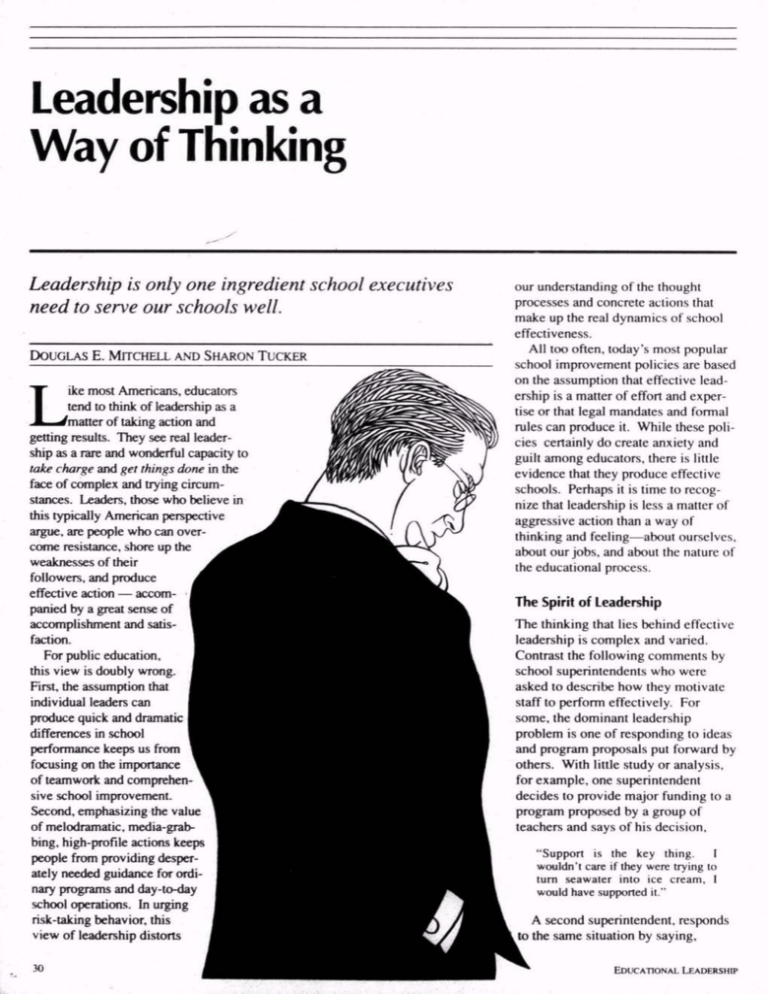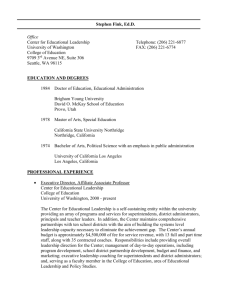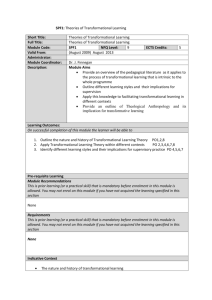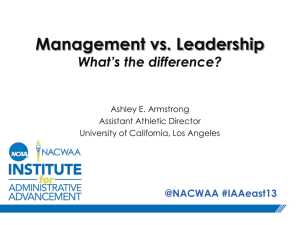
Leadership as a
Way of Thinking
Leadership is only one ingredient school executives
need to serve our schools well.
DOUGLAS E. MTTCHELL AND SHARON TUCKER
L
ike most Americans, educators
tend to think of leadership as a
matter of taking action and
getting results. They see real leader
ship as a rare and wonderful capacity to
take charge and get things done in the
face of complex and trying circum
stances. Leaders, those who believe in
this typically American perspective
argue, are people who can over
come resistance, shore up the
weaknesses of their
followers, and produce
effective action
accom
panied by a great sense of
accomplishment and satis
faction.
For public education,
this view is doubly wrong.
First, the assumption that
individual leaders can
produce quick and dramatic
differences in school
performance keeps us from
focusing on the importance
of teamwork and comprehen
sive school improvement.
Second, emphasizing the value
of melodramatic, media-grab
bing, high-profile actions keeps
people from providing desper
ately needed guidance for ordi
nary programs and day-to-day
school operations. In urging
risk-taking behavior, this
view of leadership distorts
30
our understanding of the thought
processes and concrete actions that
make up the real dynamics of school
effectiveness.
All too often, today's most popular
school improvement policies are based
on the assumption that effective lead
ership is a matter of effort and exper
tise or that legal mandates and formal
rules can produce it. While these poli
cies certainly do create anxiety and
guilt among educators, there is little
evidence that they produce effective
schools. Perhaps it is time to recog
nize that leadership is less a matter of
aggressive action than a way of
thinking and feeling about ourselves,
about our jobs, and about the nature of
the educational process.
The Spirit of Leadership
The thinking that lies behind effective
leadership is complex and varied.
Contrast the following comments by
school superintendents who were
asked to describe how they motivate
staff to perform effectively. For
some, the dominant leadership
problem is one of responding to ideas
and program proposals put forward by
others. With little study or analysis,
for example, one superintendent
decides to provide major funding to a
program proposed by a group of
teachers and says of his decision,
"Support is the key thing.
I
wouldn't care if they were trying to
turn seawater into ice cream, I
would have supported it."
A second superintendent, responds
to the same situation by saying.
EDUCATIONAL LEADERSHIP
"In this district, when teachers,
parents, or administrators decide a
problem needs to be addressed, we
form a study group. Everyone is
assigned research articles to read,
and when they come together to
share what they have learned, they
debate, talk about the idea's appli
cation, about where we are headed.
We bring in outside experts to
speak to the group. Only then do
we financially support a change and
make it part of the district's
program."
For other superintendents, staff
leadership means finding ways to
draw attention to their own versions of
good program and policy ideas, rather
than reacting to ideas or pressures
arising from others. One superinten
dent in a mid-sized urban school
district visits every classroom in the
district four times a year. It is a major
undertaking, but he makes this "big
commitment" in order to interact
informally with staff and engage them
in discussions of possible new direc
tions. On his visits he makes a point
of talking about innovations currently
under way in the district.
Another superintendent organizes a
yearly management retreat with princi
pals. She explicitly addresses the
issue of districtwide goal setting and
insists on discussing with everyone
district program priorities and strate
gies for achieving them. She believes
that it is crucial that everyone be able
to philosophically "buy into" the
district priorities and that all have a
feeling of "being in it together."
So much variability exists among
these superintendents and in their
work settings that it is difficult to get a
handle on the characteristics of
successful influence over instructional
programs. Settings range from large
to small districts, from urban to rural
environments. Occasionally boards of
education or labor problems make
FEBRUARY 1992
some climates contentious. Others
have relatively peaceful settings where
board members have long tenures or
have broad agreement on basic goals.
The superintendents, both men and
women, some in their 40s and some in
their 60s, also vary in personality and
style. Their personal characteristics,
their organizational environments, and
the kinds of communities in which
they work influence their leadership
style and emphasis.
One common feature is clear,
however. These superintendents, like
the principals in each of their districts,
seek to control, or at least signifi
cantly influence, school performance.
How they seek to gain influence
varies, as do the goals toward which
they direct their efforts. If. we could
clarify the sources and aims of execu
tive influence in public education, we
would add much to the current
debates over how school performance
can be improved.
Superintendents' leadership springs
from the way they think. Effective
action follows from effective thinking
in ways that are far too richly textured
and varied to be captured in any list of
supposedly effective leadership strate
gies. For this reason, recent studies of
Leadership is less a
matter of aggressive
action than a way of
thinking and feeling
about ourselves, about
our jobs, and about
the nature of the
educational process.
school effectiveness have often found
it necessary to talk of the "ethos" or
"culture" of the school. Cultures
guide thinking and feeling and influ
ence behavior by helping people to get
a "feel for" the situation in which they
find themselves. Cultures create and
constrain executive behavior by gener
ating values rather than directives.
They create social norms and draw
attention to opportunities for action;
they do not specify exactly what to do
or how to do it.
School performance is just as
closely tied to competent administra
tion, effective supervision, and
dynamic management as it is to
aggressive leadership. Indeed, educa
tors who succeed in producing a
balanced integration of the work
orientations and actions implied in
these four concepts are much more
likely to stimulate high performance in
their schools than those who give
themselves to a one-dimensional lead
ership or management emphasis.
Transactional vs. Transformative
Leadership
As vividly expressed in James
McGregor Burns' seminal analysis of
leadership, some cultures emphasize
transactional control through the
distribution of incentives, while others
work by transforming the goals and
aspirations of organization members.
The first type of culture creates a
system of economic, political, or
psychological incentives for hard
work and successful performance of
assigned tasks. Transactional leader
ship only works, unfortunately, when
both leaders and followers understand
and agree about the important tasks to
be performed. To acquire leadership
in such a cultural setting it is also
necessary to get control over the
incentive system
to be able to
31
reward high performance or, if neces
sary, to punish those who refuse to
cooperate.
Transformational leadership, by
contrast, arises when leaders are more
concerned about gaining overall coop
eration and energetic participation
from organization members than they
are in getting particular tasks
performed. If leaders are working in
cultural settings where goals are
unclear or organizational members do
not agree about them, effective leader
ship requires an approach that trans
forms the feelings, attitudes, and
beliefs of their followers. Compliance
is not enough under these circum
stances; it is important to get followers
to believe in themselves and in the
goals of the organization. Transforma
tional leaders are "people oriented";
rather than focus on tasks and perfor
mance, they build relationships and
help followers develop goals and iden
tify strategies for their accomplish
ment.
The difference between transactional and transformational control
systems can be seen in superinten
dents. Transactional superintendents
seek indirect control through attention
to the design of district organizational
structures. They give careful thought to
how organizational structures serve to
facilitate or impede the work of the
school staff. Transformational superin
tendents think quite differently. They
give primary attention to the staffs
rather than the structures.
Transactional superintendents,
concerned with structures, concentrate
on defining job functions and on
developing district policies and proce
dures. They believe that if they
succeed in improving organizational
operations, school instructional
improvement will follow. They
concentrate on creating and stabilizing
district programs. They have a high
32
sensitivity to hierarchy and standard
ization of practices.
Transformational superintendents,
concerned with staff skills and beliefs,
direct their efforts to building and
strengthening organizational norms
and attitudes. They strive to establish
common meaning systems, believing
School performance is
just as closely tied
to competent
administration,
effective supervision,
and dynamic
management
as it is to
aggressive leadership.
that quality education will arise when
professional staff agree about educa
tional goals and the most effective
strategies for their attainment.
Frontier vs. Settled Cultures
Cross-cutting the transaction/transfor
mation dimension of relationship
between leaders and followers is the
cultural role of the school organiza
tion. The primary issue in this second
cultural dimension is whether the
schools are seen as part of an estab
lished, successful system for the
socialization of the young or as institu
tions in need of redirection and
reform, restructuring to meet new
conditions or reach new goals.
In some communities and in some
historical periods, schools enjoy broad
community support based on a widely
shared consensus about the purposes
and processes of education. In the
beginning of the 19th century, for
example, there was a near-universal
enthusiasm for schools as the source
of economic opportunity and civic
culture. Even today, schools serving
middle- and upper-class families in
many suburban communities continue
to enjoy widespread support as a
natural adjunct to family and commu
nity socialization. More typically,
however, today's schools are troubled
institutions
they are often labeled
failures and challenged to change their
goals while at the same time radically
improving performance in traditional
areas of emphasis.
The difference between these two
cultural settings is much like the
difference between frontier life and
settled communities. In frontier
cultures life is rough, danger is every
where, and groups have to band
together for mutual support and
protection. Frontier leadership
emphasizes culture building and
problem solving
individual differ
ences may be respected, but there is an
obvious need for common experiences
and a shared commitment to the
emerging community.
In settled cultures, by contrast, wellestablished norms and shared beliefs
interpret ordinary activities and guide
the inhabitants. These same beliefs
baffle newcomers and prevent
minority group members from experi
encing full membership in the commu
nity. Stable schools with settlement
cultures develop programs that are
sensible; tasks and relationships are
both well-specified. Effective leader
ship in a settlement culture rests on
coordination and expertise
programs
can be planned in detail, and task
assignments can be fully specified. In
this type of cultural setting the most
EDUCATIONAL LEADERSHIP
productive approach to leadership often
involves concentrating on recruiting
good staff members and coordinating
support services
leaving work on
core tasks to staff experts.
Culture and Work Role
The two cultural dimensions just
described intersect to define supervi
sion, administration, management, and
leadership
the four key terms in the
lexicon of control over school perfor
mance (see fig. 1). When schools are
well established and their cultural role
is settled, supervision and administra
tion are the dominant processes.
When confidence is lost and new fron
tiers are being crossed, dynamic
management and aggressive leader
ship are required. Supervision shares
with management (rather than admin
istration) a common reliance on incen
tive systems and transactional control.
When organization members lack
common incentives and goals and need
to be energized and engaged in trans
forming interpersonal relationships in
Transformational
leadership arises
when leaders are
more concerned about
gaining overall
cooperation and
energetic participation
from organization
members than they are
in getting particular
tasks performed.
FEBRUARY 1992
order to define or restructure their
work activities, administration and
leadership become dominant functions.
Changing circumstances and
changing beliefs about the schools
encourage educators to give primary
emphasis to one rather than another of
these basic work orientations. As
superintendents, principals, and other
school staff respond to the underlying
cultural dimensions, they change their
thinking about how school perfor
mance should be controlled. With
these changes in thinking about effec
tiveness come basic changes in concep
tions of effective teaching, strategies
for school improvement, and beliefs
about how to influence the work
behavior of school staff members.
Supervision. Educators who see the
school as a stable, broadly supported
social institution and who think about
interpersonal influence in transac
tional, incentive-based ways, will give
primary emphasis to supervision in
defining their own role. Supervisors
in these environments tend to assume
that educational goals are obvious to
everyone. If there is difficulty it is
because some people are unable or
unwilling to work effectively to attain
them. The supervisory approach gives
superintendents and principals respon
sibility for identifying specific tasks
and directing staff in how each is to be
performed. They closely monitor staff
to ensure that directions are being
followed and that performance is high.
The supervisory orientation to
school effectiveness brings with it the
belief that teachers can be effective if
they will diligently implement good
standard classroom practices. Within
this cultural view, good teachers are
seen as loyal laborers working on
tasks defined by curriculum experts
and overseen by principals. School
improvement is a matter of teacher
diligence and conscientiousness rather
FIGURE
1
CULTURE AND
WORK ROLE DEFINITIONS
Settlement
Culture*
Trensactlonal
Transformational
Supervisor
Administrator
Manager
Leader
> Standardized
Wo*
Actrvr.e.
Frontter
Cultures
Probtom
SoVmgWorfc
ActrvitiM
than creativity or spontaneity. Student
achievement is equated with mastering
materials, and teaching effectiveness
with careful implementation of estab
lished programs. Supervisors
subscribe to the world view expressed
in most reforms adopted after the
publication of A Nation at Risk ( 1983)
better schooling results from longer
hours, more requirements, stronger
mandates, and, above all, an account
ability system that ties incentives
directly to measured student achieve
ment.
Administration. Educators who feel
that their control over meaningful
incentives is weak, or who simply
believe that school effectiveness rests
more on the attitudes of teachers and
students than on the implementation of
specific programs, will adopt an
administrative approach to influencing
school performance. The administra
tive work orientation shares with the
supervisory one the settlement
culture's confidence that the overall
goals of education are well understood
and supported. These administrators
do not feel a need to redirect teachers
or students to new learning objectives
or to reconsider the efficacy of
existing school programs.
From this perspective, high-quality
33
teaching depends on giving teachers
more professional autonomy. Effec
tive teachers creatively diagnose
student learning styles and problems
and develop their own techniques for
encouraging achievement within
established programs and practices.
Indeed, those who adopt an adminis
trative orientation to school improve
ment believe that teaching and
learning are rather private and individ
ualized processes
not amenable to
either direct oversight or explicit
rewards and sanctions. Curriculum
and child development specialists help
ensure effective instruction by identi
fying and helping to remediate chil
dren's special learning problems. To
increase their effectiveness, profes
sional teachers and specialists form
into a cohesive team. Administrators
give a lot of attention to interpersonal
dynamics
they talk about the
importance of good communication
and emphasize their role in recruiting,
supporting, and coordinating staff
activities. When they identify perfor
mance problems, they make every
effort to create a transformational rela-
Melodramatic claims
about school failures
are a basic ingredient
in the shift from the
management focus of
the '70s and '80s to
the emphasis on
restructuring and
transformational
leadership in the 1990s.
34
tionship with teachers and students.
They use counseling, staff develop
ment, and day-to-day interactions to
ensure that their staffs fully participate
in the established program.
Management. When educators
sense that broad social support for
education is no longer available, when
change is more important than imple
mentation of established programs, it
makes sense to shift from supervision
to management. Managers, like super
visors, rely more on transactional than
transformational relationships. They
see effective teaching as the result of
competence and skill. Task definition
is more important than nurturing inter
personal relationships. For the
manager, teaching is a skilled craft and
is improved by careful program design
and application of sophisticated
instructional techniques. Good
programs are those that are fully
researched and carefully planned.
Where supervisors tend to think of
getting people to work harder,
managers think they need to work
smarter. They value effective analysis
of school performance problems and
staff training. Managers are likely to
emphasize the importance of perfor
mance indicators and to want explicit
measures of school productivity.
Leadership. Where weakened
social and cultural support for the
schools is accompanied by a belief
that high performance depends on
transforming student and teacher atti
tudes and beliefs (not just redirecting
their behavior), leadership becomes
the dominant theme in school improve
ment. Leaders, like managers, recog
nize that support for their organiza
tions depends upon making qualitative
changes in their performance. Unlike
managers, however, leaders do not
believe that either the incentive system
or the knowledge base for effective
performance is adequately developed.
Transformational
leaders see themselves
as responsible more for
redefining educational
goals than for
implementing existing
programs.
A belief in the transformational
leadership approach to school
improvement leads easily to concepts
like "restructuring" or "re-inventing"
school organizations. Transforma
tional leaders see themselves as
responsible more for redefining educa
tional goals than for implementing
existing programs. They believe that
high-performance teachers are more
like creative artists than skilled craft
workers. Teachers are talented
experts. Because of their creative
talents, they know what is important
for children and how to make schools
work. Leadership-oriented executives
assume, however, that teaching talent
becomes effective only when it is inte
grated into cohesive, coordinated
activity. Their effectiveness depends on
everyone working together, developing
and then pursuing common goals.
Leadership-oriented executives
think of high performance the way a
drama coach or concert master does
the important thing is to solicit full
engagement and release energy.
School improvement is, therefore, a
matter of realigning school programs
with the needs and interests of
communities, families, students, and
school staff. These transformational
leaders see the central issue as
commitment rather than competence.
EDUCATIONAL LEADERSHIP
Of course, effective teachers will need
to be competent, but the key problem
for improved schools is harnessing
teacher competence to a new set of
program goals.
Leadership is Only Part of the Story
It is not surprising that today's educa
tion policymakers and school
reformers are talking about the critical
importance of leadership for principals
and superintendents. They are
reflecting their own belief that schools
have to change program goals in order
to prepare workers for an international
economy and citizens for a turbulent
and pluralistic civic culture. As the
superintendents we studied made
crystal clear, however, transforma
tional leadership is not the only route
to improved school performance.
Melodramatic claims about school
failures are a basic ingredient in the
shift from the management focus of
the '70s an '80s to the emphasis on
restructuring and transformational
leadership in the 1990s. It is vitally
important to recognize that failures
and shortcomings, just like success
and high performance, come in many
different forms. Where the problem is
changing goals and redirecting belief
systems, all shortcomings will be
interpreted as comprehensive and
catastrophic. The "little failures" of
poor organization and technically
weak programs may ultimately be the
most important, however. And these
little failures can be more easily reme
died through energetic management,
bupportive administration, or directive
supervision than by the melodrama of
charismatic leadership.
Public education and the nation's
children will be well served if school
executives devote as much skill and
energy to supervising well-established
programs, administering to the needs
FEBRUARY 1992
of teachers and students, and
managing the utilization of scarce
resources as they are now being urged
to spend on mobilizing and focusing
energy on sweeping revisions and
fundamental changes. As important as
it is to redefine educational goals and
restructure school programs to pursue
them, this kind of frontier leadership is
only one part of a balanced approach
to creating and sustaining high perfor
mance in schools. L
Authors' note: The leadership concepts
developed in this article are taken from our
studies of principal and superintendent
effectiveness. The focus of these studies
have been on how these school executives
succeed in influencing teacher behavior
and school performance.
'J. M. Bums. (1978), Leadership (New
York: Harper & Row).
Douglas E. Mitchell is Professor of
Education and Director of the California
Educational Research Cooperative. School
of Education. University of California,
Riverside. Riverside. CA 92521. Sharon
Tucker is Deputy Superintendent of
Instructional Services. Riverside Unified
School District. Riverside, CA 92521.
HARVARD UNIVERSITY
THH PRINCIPALS'(TXTFR
LEADERSHIP: AN EVOLVING VISION
June 30-July 10,1992
A program for experienced principals, focusing on shared
leadership, coalition building, school culture, ethics, and vision.
THE ART AND CRAFT OF THE PRINOPALSHIP
1
July 13-23,1992
A program for new and aspiring principals, focusing on
school change, school and community coalitions, developing
staff support, and restructuring the workplace.
APPLICATION DEADLINE APRIL 3,1992
For information on these programs, contact
Programs in Professional Education
339L Gutman Library
Harvard Graduate School of Education
Cambridge, MA 02138
(617)495-3572 FAX 617-4964051
Copyright © 1992 by the Association for Supervision and Curriculum
Development. All rights reserved.








